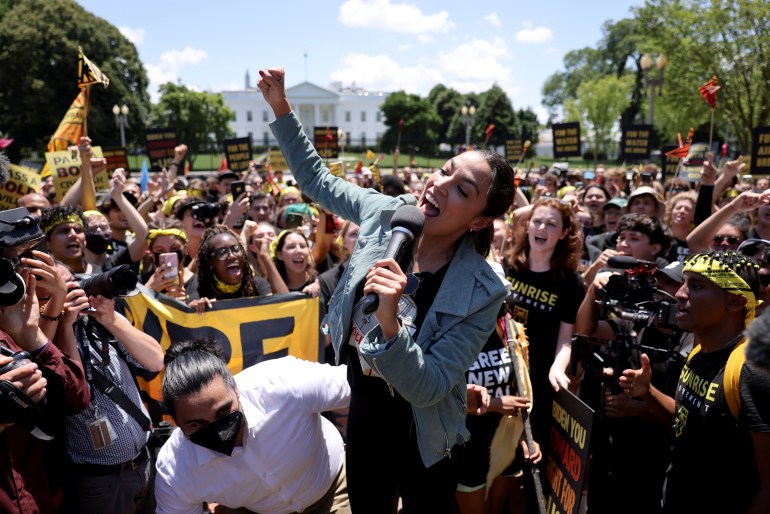United States nears first major steps to control CO2 emissions
As scientists raise alarm on global warming, the US is close to adopting sweeping green energy and emissions measures.

The United States is preparing to adopt a raft of new energy policies that will for the first time put the US – the world’s second-worst polluter after China – on a path to meeting its pledge to cut greenhouse emissions in half by 2035.
In a series of measures pending on Tuesday before the US Congress and new directives by the Biden administration, the US economy would begin a broad shift to electric vehicles, solar and wind with reductions in carbon pollution from fossil fuels.
Keep reading
list of 4 items‘World War Zero’: Biden names John Kerry as US climate envoy
US climate envoy Kerry to visit Shanghai for climate talks
EU reaches ambitious climate deal that could transform economy
“We are moving in the right direction. The question is, will we move fast enough,” said Dan Lashof, the US director of the World Resources Institute, a global research organisation dedicated to working with governments on climate change.
The UN’s Intergovernmental Panel on Climate Change issued a dire report on August 9 that concludes global warming is happening faster than previously understood and drastic cuts to worldwide emissions are needed to hold the global temperature rise under 2C (3.6F) – the threshold to avoid devastating consequences for humanity.
Since taking office in January, President Joe Biden has rejoined the Paris climate accord – abandoned by his predecessor Donald Trump – and pledged to cut US greenhouse emissions 50 percent.
After China, the US is the second-largest producer of greenhouses gases in the world emitting more than 6.6 billion tonnes of CO2 per year.
“We have got to cut our emissions by 50 percent or more this decade to have a shot at limiting warming to less than 2C,” Lashof told Al Jazeera.
Clean energy
Major incentives and investments for new clean energy are contained in two major pieces of legislation now pending in Congress, a $1 trillion infrastructure spending bill and a $3.5 trillion budget policy.
Both passed the US Senate and are headed for consideration in the House of Representatives this week where Democratic Party unity – which has been shaken – will be required to win passage.

The infrastructure bill, which passed the Senate on a bipartisan vote of 69-30, includes $65bn to modernise the ageing US electric grid, boost carbon-capture technologies and shift power generation to clean sources like hydrogen.
It further includes $7.5bn for electric vehicle charging stations – key to enabling mainstream adoption of electric vehicles – and $5bn for government purchases of electric and hybrid school buses.
These new federal investments “are helpful”, Lashof said, “but by themselves are by no means adequate”.
New policies
More of the effect from what the US is considering is to be found in an enormous $3.5 trillion budget measure, which sets broad top-line spending goals for Congress.
“We will take on the existential threat of climate change by transforming our energy systems toward renewable energy and energy efficiency,” Senator Bernie Sanders, chairman of the Senate Budget Committee said when the budget resolution passed the Senate on August 10.
The budget bill includes clean energy, manufacturing, and transportation tax incentives and carbon polluter fees, clean energy technology, clean electricity rebates, financing and research.

The budget authorises up to $135b across five years for a Civilian Climate Corps to be composed of hundreds of thousands of young workers similar to the US’s 1930s-era Civilian Conservation Corps to work on green public projects.
Corpsmembers would be paid $15 an hour and receive educational benefits for work on renewable energy projects and community conservation.
Final details of many of the Climate Corps plan and other clean energy policies are being hammered out in congressional committees across Congress and will be passed in spending bills to be approved in September.
Electric vehicles
A new executive order signed by President Joe Biden on August 5 calls for half of all new vehicle sales in the US to be electric by 2030. At the same time, Biden ordered tougher emissions and fuel economy standards for gas vehicles.
“In order to meet the US’s environmental goals, we have to electrify and clean our transportation system, starting from the light-duty vehicles to transit, heavy-duty and everything else,” said Gil Tal, director of electric vehicle research at the University of California-Davis.
In light of the UN’s alarming report, the imperative to shift to electric vehicles is urgent, Tal told Al Jazeera. “There is no way to do enough right now. Whatever we can do, we need to push to the max,” Tal said.
In California, the US’s most populous state, where climate-driven wildfires are raging now for a fourth consecutive summer, Governor Gavin Newsom has ordered that all new cars and trucks sold in the state must be electric by 2035.
Narrow path
The prospect of congressional approval of new funding and policies to address climate change and cut US emissions is a win for progressives like Sanders and the Democratic Party’s Representative Alexandria Ocasio-Cortez who had campaigned on the issue in 2020.
“We’ve had four years of Trump and we’re back in the Paris agreement,” Lashof said.
“The risk is that this is just barely enough if it all gets through. It’s a serious setback if it gets pared back.”
While both the infrastructure bill and budget measure appear headed in tandem for congressional passage, the internal politics in Washington remain tricky and the path to approval is narrow.

House Democrats hold only a 220 to 212 seat majority over Republicans, which leaves House Speaker Nancy Pelosi little room to manoeuvre between warring progressive and moderate wings of her party.
House leaders have set votes on the infrastructure and budget measures as soon as Tuesday.